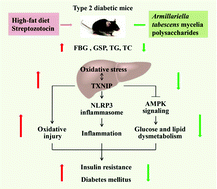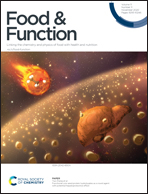Polysaccharides from Armillariella tabescens mycelia ameliorate insulin resistance in type 2 diabetic mice
Abstract
Type 2 diabetes mellitus (T2DM) is a chronic metabolic disorder characterized by hyperglycemia mainly due to insulin resistance. The objective of this study was to investigate the effects of polysaccharides from Armillariella tabescens mycelia (AT) on insulin resistance in mice fed a high-fat diet in combination with streptozotocin to induce T2DM. Following treatment with different doses of AT, hyperglycemia and lipid metabolism dysfunction, insulin resistance, and hepatic function-related indices were markedly ameliorated; the histopathological alterations, oxidative stress, and inflammatory reaction in hepatic tissue were also alleviated; most importantly, AT inhibited the expression of hepatic thioredoxin-interacting protein (TXNIP) to repress the nucleotide-binding oligomerization domain-like receptor protein 3 (NLRP3) inflammasome activation and activated the 5′AMP-activated protein kinase (AMPK) pathway in a dose-dependent manner in T2DM mice. In conclusion, these findings revealed that the hypoglycemic and hypolipidemic activities of AT were associated with the alleviation of insulin resistance through repression of the TXNIP/NLRP3 inflammasome pathway and activation of the AMPK pathway.



 Please wait while we load your content...
Please wait while we load your content...